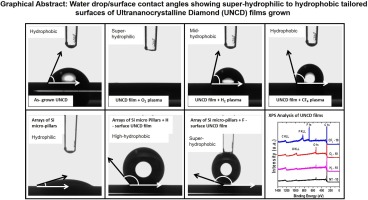Our official English website, www.x-mol.net, welcomes your
feedback! (Note: you will need to create a separate account there.)
Tailoring of Polycrystalline Diamond Surfaces from Hydrophilic to Superhydrophobic via Synergistic Chemical plus Micro-structuring Processes
Carbon ( IF 10.5 ) Pub Date : 2018-11-01 , DOI: 10.1016/j.carbon.2018.06.062 A. Gabriela Montaño-Figueroa , Jesus J. Alcantar-Peña , Pablo Tirado , Alejandro Abraham , Elida de Obaldia , Orlando Auciello
Carbon ( IF 10.5 ) Pub Date : 2018-11-01 , DOI: 10.1016/j.carbon.2018.06.062 A. Gabriela Montaño-Figueroa , Jesus J. Alcantar-Peña , Pablo Tirado , Alejandro Abraham , Elida de Obaldia , Orlando Auciello

|
Abstract The wettability properties of the surfaces of polycrystalline diamond films, grown by Hot Filament Chemical Vapor Deposition, with different grain sizes, ranging from microcrystalline diamond (MCD), to nanocrystalline diamond (NCD), to ultrananocrystalline diamond (UNCD), were successfully tailored from as-grown flat semi-hydrophobic to hydrophilic surfaces, via oxygen (O2) plasma treatment, to highly-hydrophobic by carbon tetrafluoride (CF4) plasma treatment, and to super-hydrophobic diamond surface, via synergistic tailoring of surface chemistry and 3-D texturing. Raman spectroscopy analysis and secondary electron microscopy revealed the Hydrogen-surface termination and increased grain size, respectively, of the diamond films. Atomic Force Microscopy imaging of the plasma-treated UNCD films revealed no significant change in the surface roughness after either O2 or CF4 treatments. Nevertheless, a surface-chemistry alteration was confirmed by X-ray Photoelectron Spectroscopy. Finally, the synergistic combination of 3-D surface structuring and plasma-induced fluorine atoms surface termination of UNCD films produced a superhydrophobic state as revealed by a Water Contact Angle (WCA) close to ∼174°, thus producing the highest superhydrophobic surface of diamond material demonstrated today. The metastable Cassie-Baxter state, for the superhydrophobic 3-D UNCD surface, was demonstrated via a close correlation between the mathematical calculation based on the Cassie-Baxter Model and the experimental measurement of the WCA.
中文翻译:

通过协同化学加微结构化工艺将多晶金刚石表面从亲水性裁剪为超疏水性
摘要 通过热丝化学气相沉积法生长的多晶金刚石薄膜的表面润湿性被成功地定制,具有不同的晶粒尺寸,从微晶金刚石 (MCD) 到纳米晶金刚石 (NCD),再到超纳米晶金刚石 (UNCD)。从生长的扁平半疏水表面到亲水表面,通过氧 (O2) 等离子体处理,到四氟化碳 (CF4) 等离子体处理的高度疏水,再到超疏水金刚石表面,通过协同定制表面化学和 3- D 纹理。拉曼光谱分析和二次电子显微镜分别揭示了金刚石薄膜的氢表面终止和增加的晶粒尺寸。等离子处理的UNCD 薄膜的原子力显微镜成像显示在O2 或CF4 处理后表面粗糙度没有显着变化。尽管如此,X 射线光电子能谱证实了表面化学变化。最后,UNCD 薄膜的 3-D 表面结构和等离子体诱导的氟原子表面终止的协同组合产生了超疏水状态,如接近 174° 的水接触角 (WCA) 所揭示的那样,从而产生了金刚石的最高超疏水表面今天展示的材料。通过基于 Cassie-Baxter 模型的数学计算与 WCA 的实验测量之间的密切相关性,证明了超疏水 3-D UNCD 表面的亚稳态 Cassie-Baxter 状态。尽管如此,X 射线光电子能谱证实了表面化学变化。最后,UNCD 薄膜的 3-D 表面结构和等离子体诱导的氟原子表面终止的协同组合产生了超疏水状态,如接近 174° 的水接触角 (WCA) 所揭示的那样,从而产生了金刚石的最高超疏水表面今天展示的材料。通过基于 Cassie-Baxter 模型的数学计算与 WCA 的实验测量之间的密切相关性,证明了超疏水 3-D UNCD 表面的亚稳态 Cassie-Baxter 状态。尽管如此,X 射线光电子能谱证实了表面化学变化。最后,UNCD 薄膜的 3-D 表面结构和等离子体诱导的氟原子表面终止的协同组合产生了超疏水状态,如接近 174° 的水接触角 (WCA) 所揭示的那样,从而产生了金刚石的最高超疏水表面今天展示的材料。通过基于 Cassie-Baxter 模型的数学计算与 WCA 的实验测量之间的密切相关性,证明了超疏水 3-D UNCD 表面的亚稳态 Cassie-Baxter 状态。3-D 表面结构和 UNCD 膜的等离子体诱导氟原子表面终止的协同组合产生了超疏水状态,如接近 174° 的水接触角 (WCA) 所揭示的那样,从而产生了金刚石材料的最高超疏水表面。今天。通过基于 Cassie-Baxter 模型的数学计算与 WCA 的实验测量之间的密切相关性,证明了超疏水 3-D UNCD 表面的亚稳态 Cassie-Baxter 状态。3-D 表面结构和 UNCD 膜的等离子体诱导氟原子表面终止的协同组合产生了超疏水状态,如接近 174° 的水接触角 (WCA) 所揭示的那样,从而产生了金刚石材料的最高超疏水表面。今天。通过基于 Cassie-Baxter 模型的数学计算与 WCA 的实验测量之间的密切相关性,证明了超疏水 3-D UNCD 表面的亚稳态 Cassie-Baxter 状态。
更新日期:2018-11-01
中文翻译:

通过协同化学加微结构化工艺将多晶金刚石表面从亲水性裁剪为超疏水性
摘要 通过热丝化学气相沉积法生长的多晶金刚石薄膜的表面润湿性被成功地定制,具有不同的晶粒尺寸,从微晶金刚石 (MCD) 到纳米晶金刚石 (NCD),再到超纳米晶金刚石 (UNCD)。从生长的扁平半疏水表面到亲水表面,通过氧 (O2) 等离子体处理,到四氟化碳 (CF4) 等离子体处理的高度疏水,再到超疏水金刚石表面,通过协同定制表面化学和 3- D 纹理。拉曼光谱分析和二次电子显微镜分别揭示了金刚石薄膜的氢表面终止和增加的晶粒尺寸。等离子处理的UNCD 薄膜的原子力显微镜成像显示在O2 或CF4 处理后表面粗糙度没有显着变化。尽管如此,X 射线光电子能谱证实了表面化学变化。最后,UNCD 薄膜的 3-D 表面结构和等离子体诱导的氟原子表面终止的协同组合产生了超疏水状态,如接近 174° 的水接触角 (WCA) 所揭示的那样,从而产生了金刚石的最高超疏水表面今天展示的材料。通过基于 Cassie-Baxter 模型的数学计算与 WCA 的实验测量之间的密切相关性,证明了超疏水 3-D UNCD 表面的亚稳态 Cassie-Baxter 状态。尽管如此,X 射线光电子能谱证实了表面化学变化。最后,UNCD 薄膜的 3-D 表面结构和等离子体诱导的氟原子表面终止的协同组合产生了超疏水状态,如接近 174° 的水接触角 (WCA) 所揭示的那样,从而产生了金刚石的最高超疏水表面今天展示的材料。通过基于 Cassie-Baxter 模型的数学计算与 WCA 的实验测量之间的密切相关性,证明了超疏水 3-D UNCD 表面的亚稳态 Cassie-Baxter 状态。尽管如此,X 射线光电子能谱证实了表面化学变化。最后,UNCD 薄膜的 3-D 表面结构和等离子体诱导的氟原子表面终止的协同组合产生了超疏水状态,如接近 174° 的水接触角 (WCA) 所揭示的那样,从而产生了金刚石的最高超疏水表面今天展示的材料。通过基于 Cassie-Baxter 模型的数学计算与 WCA 的实验测量之间的密切相关性,证明了超疏水 3-D UNCD 表面的亚稳态 Cassie-Baxter 状态。3-D 表面结构和 UNCD 膜的等离子体诱导氟原子表面终止的协同组合产生了超疏水状态,如接近 174° 的水接触角 (WCA) 所揭示的那样,从而产生了金刚石材料的最高超疏水表面。今天。通过基于 Cassie-Baxter 模型的数学计算与 WCA 的实验测量之间的密切相关性,证明了超疏水 3-D UNCD 表面的亚稳态 Cassie-Baxter 状态。3-D 表面结构和 UNCD 膜的等离子体诱导氟原子表面终止的协同组合产生了超疏水状态,如接近 174° 的水接触角 (WCA) 所揭示的那样,从而产生了金刚石材料的最高超疏水表面。今天。通过基于 Cassie-Baxter 模型的数学计算与 WCA 的实验测量之间的密切相关性,证明了超疏水 3-D UNCD 表面的亚稳态 Cassie-Baxter 状态。










































 京公网安备 11010802027423号
京公网安备 11010802027423号